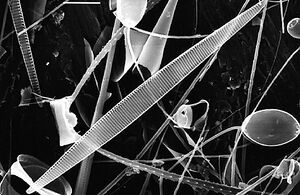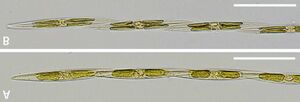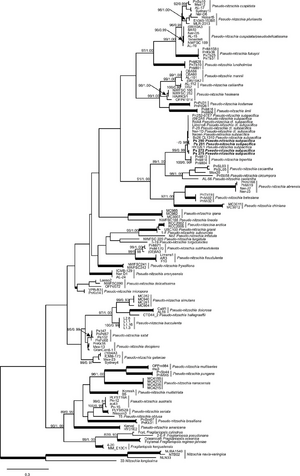Pseudo-nitzschia australis: Difference between revisions
| Line 35: | Line 35: | ||
Domoic acid, which is a water-soluble amino acid of the kainoid class, is produced by more than half of the members of the ''Pseudo-nitzschia'' genus, including, of course, ''P. australis'' (Jeffery et al., 2004). Domoic acid production seems to increase with environmental stressors, as the highest domoic acid outputs have been recorded in specimens of ''P. australis'' in less-than-optimal salinity and temperature conditions (Ayache et al., 2019). However, though silica is often a limiting factor for diatoms, there is no correlation between silica limitation and domoic acid output. In fact, silicate limitation has been found to lead to DA accumulation by inhibiting cell division with DA production still active (Sauvey et al., 2023). DA synthesis is linked to photosynthesis, which allows ''P. australis'' a higher DA production potential than others of its genus, as it has a higher photosynthetic capacity. It has also been observed that ''P. australis'' actively produces DA during its exponential growth phase, as opposed to the related ''P. multiseries'', which produces DA mostly during its stationary period. (Sauvey et al., 2023). | Domoic acid, which is a water-soluble amino acid of the kainoid class, is produced by more than half of the members of the ''Pseudo-nitzschia'' genus, including, of course, ''P. australis'' (Jeffery et al., 2004). Domoic acid production seems to increase with environmental stressors, as the highest domoic acid outputs have been recorded in specimens of ''P. australis'' in less-than-optimal salinity and temperature conditions (Ayache et al., 2019). However, though silica is often a limiting factor for diatoms, there is no correlation between silica limitation and domoic acid output. In fact, silicate limitation has been found to lead to DA accumulation by inhibiting cell division with DA production still active (Sauvey et al., 2023). DA synthesis is linked to photosynthesis, which allows ''P. australis'' a higher DA production potential than others of its genus, as it has a higher photosynthetic capacity. It has also been observed that ''P. australis'' actively produces DA during its exponential growth phase, as opposed to the related ''P. multiseries'', which produces DA mostly during its stationary period. (Sauvey et al., 2023). | ||
=Current | =Current research= | ||
''P. australis'' is currently monitored closely using SHA probes due to its toxicity in order to better understand the spatial, temporal, and successional patterns in both bloom and non-bloom periods, allowing better understanding of its growth preferences and requirements, as well as which areas might be at risk of a ASP outbreak due to the buildup of ''P. australis''-formed domoic acid in local shellfish. Almost all recent (post-2015) research about ''P. australis'' relates to its spread, growth patterns, and domoic acid output, such as the 2023 paper detailing the physiological conditions favorable to domoic acid output ''P. australis'' and related species (Sauvey et al., 2023). | ''P. australis'' is currently monitored closely using SHA probes due to its toxicity in order to better understand the spatial, temporal, and successional patterns in both bloom and non-bloom periods, allowing better understanding of its growth preferences and requirements, as well as which areas might be at risk of a ASP outbreak due to the buildup of ''P. australis''-formed domoic acid in local shellfish. Almost all recent (post-2015) research about ''P. australis'' relates to its spread, growth patterns, and domoic acid output, such as the 2023 paper detailing the physiological conditions favorable to domoic acid output ''P. australis'' and related species (Sauvey et al., 2023). | ||
Revision as of 19:14, 23 March 2024
Classification
Higher order taxa
Domain: Eukarya
Phylum: Gyrista
Class: Bacillariophyceae
Order: Bacillariales
Family: Bacillariaceae
Genus: Pseudo-nitzschia
Species
Pseudo-nitzschia australis
Description and significance
Pseudo-nitzschia australis is a species of marine diatom capable of causing harmful algae blooms (HABs) via its production of the toxic domoic acid (Nishimura et al., 2021). Due to the buildup of this toxin in shellfish, P. australis is known to cause Amnesiac Shellfish Poisoning (ASP) in humans that consume polluted shellfish, which can cause long-lasting neurological symptoms such as amnesia and dementia (Figueroa et al., 2018). ASP is known to result in symptoms ranging from gastrointestinal disturbances in light cases to neuronal degeneration and necrosis in the hippocampus in serious ones, and domoic acid ingestion of 1mg/kg is enough to induce illness (Jeffery et al., 2004). Due to this toxicity, P. australis populations are highly monitored using large-subunit ribosomal RNA (LSU rRNA)-targeted probes in both whole-cell and sandwich hybridization array (SHA) formats, though the SHA method was determined to be the most efficient detection method (Scholin et al., 2003; Bowers et al., 2017).
18S ribosomal RNA gene information
P. australis has been shown to be related to P. seriata at 95% and P. multistriata at 60%. It is also closely related to P. obtusa (Fig. 3).
Cell structure and metabolism
P. australis is a photosynthetic organism as it is classified as phytoplankton (Bates et al., 2018). They are bilaterally symmetrical, and their silica-based cell walls are known as frustrules (Fig. 1). They are also able to create a chain structure as seen in Fig. 2. They are categorized by their relatively wide lanceolate valve, at 5.5 to 8 micrometers and their two rows of poroids, differing from the closely related P. seriatas 4 denser rows (Kociolek et al., 2023).
Ecology and pathogenesis
P. australis is a marine diatom that resides at the top of the water column in temperate and sub-tropical oceans, commonly found in the waters bordering the west coast of the United States, Australia, New Zealand, and in the northern Atlantic Ocean (Kociolek et al., 2023). While itself not pathogenic, the domoic acid output by P. australis is toxic, and the level fluctuates based on the environment. While P. australis itself flourishes best at a salinity of 30-40, domoic acid output was found to be highest at a salinity of 20 (Ayache et al., 2019). Similarly, nitrate and ammonium are the optimal nitrogen sources for P. australis, but samples grown on solely urea have been shown to produce more of the toxic domoic acid (Howard et al., 2007). Due to the threat of human illness due to its toxicity, monitoring protocols have been implemented using sandwich-hybridization arrays (SHAs) used to detect P. australis as well as other Pseudo-nitzchia species (Bowers et al., 2017).
Domoic acid production
Domoic acid, which is a water-soluble amino acid of the kainoid class, is produced by more than half of the members of the Pseudo-nitzschia genus, including, of course, P. australis (Jeffery et al., 2004). Domoic acid production seems to increase with environmental stressors, as the highest domoic acid outputs have been recorded in specimens of P. australis in less-than-optimal salinity and temperature conditions (Ayache et al., 2019). However, though silica is often a limiting factor for diatoms, there is no correlation between silica limitation and domoic acid output. In fact, silicate limitation has been found to lead to DA accumulation by inhibiting cell division with DA production still active (Sauvey et al., 2023). DA synthesis is linked to photosynthesis, which allows P. australis a higher DA production potential than others of its genus, as it has a higher photosynthetic capacity. It has also been observed that P. australis actively produces DA during its exponential growth phase, as opposed to the related P. multiseries, which produces DA mostly during its stationary period. (Sauvey et al., 2023).
Current research
P. australis is currently monitored closely using SHA probes due to its toxicity in order to better understand the spatial, temporal, and successional patterns in both bloom and non-bloom periods, allowing better understanding of its growth preferences and requirements, as well as which areas might be at risk of a ASP outbreak due to the buildup of P. australis-formed domoic acid in local shellfish. Almost all recent (post-2015) research about P. australis relates to its spread, growth patterns, and domoic acid output, such as the 2023 paper detailing the physiological conditions favorable to domoic acid output P. australis and related species (Sauvey et al., 2023).
References
Ayache N, Hervé F, Lundholm N, Amzil Z, Caruana AMN. Acclimation of the Marine Diatom Pseudo-nitzschia australis to Different Salinity Conditions: Effects on Growth, Photosynthetic Activity, and Domoic Acid Content1. J Phycol. 2020 Feb;56(1):97-109. doi: 10.1111/jpy.12929. Epub 2019 Nov 15. PMID: 31591715.
Bates, Stephen, Hubbard, Katharine, Lundholm, Nina, Montresor, Marina, Leaw, Chui. (2018) Pseudo-nitzschia, Nitzschia, and domoic acid: New research since 2011. Harmful Algae. Volume 79. Pages 3-43. ISSN 1568-9883. https://doi.org/10.1016/j.hal.2018.06.001.
Bowers, H, Marin, R, Birch, J, Scholin, C. (2017) Sandwich hybridization probes for the detection of Pseudo-nitzschia (Bacillariophyceae) species: An update to existing probes and a description of new probes, Harmful Algae, Volume 70, Pages 37-51, ISSN 1568-9883, https://doi.org/10.1016/j.hal.2017.10.005.
Figueroa, Rosa, Estrada, Marta, Garcés, Esther. (2018) Life histories of microalgal species causing harmful blooms: Haploids, diploids and the relevance of benthic stages. Harmful Algae,Volume 73. Pages 44-57. ISSN 1568-9883. doi: /10.1016/j.hal.2018.01.006.
Jeffery B., Barlow, T., Moizer, K., Paul, S., Boyle, C. Amnesic shellfish poison. Food and Chemical Toxicology. Volume 42, Issue 4. 2004. Pages 545-557. ISSN 0278-6915. https://doi.org/10.1016/j.fct.2003.11.010.
Kociolek, J.P.; Blanco, S.; Coste, M.; Ector, L.; Liu, Y.; Karthick, B.; Kulikovskiy, M.; Lundholm, N.; Ludwig, T.; Potapova, M.; Rimet, F.; Sabbe, K.; Sala, S.; Sar, E.; Taylor, J.; Van de Vijver, B.; Wetzel, C.E.; Williams, D.M.; Witkowski, A.; Witkowski, J. (2023) DiatomBase. Pseudo-nitzschia australis Frenguelli, 1939. Accessed through: World Register of Marine Species at: https://www.marinespecies.org/aphia.php?p=taxdetails&id=246604 on 2023-03-20
Nishimura T, Murray JS, Boundy MJ, Balci M, Bowers HA, Smith KF, Harwood DT, Rhodes LL. (2021) Update of the Planktonic Diatom Genus Pseudo-nitzschia in Aotearoa New Zealand Coastal Waters: Genetic Diversity and Toxin Production. Toxins (Basel). Sep 10;13(9):637. doi: 10.3390/toxins13090637. PMID: 34564641; PMCID: PMC8473122.
Quijano-Scheggia S., Olivos-Ortiz, A., Garcia-Mendoza, E., Sánchez-Bravo, Y., Sosa-Avalos, R., Salas Marias, N., Lim, H. (2020) Phylogenetic relationships of Pseudo-nitzschia subpacifica (Bacillariophyceae) from the Mexican Pacific, and its production of domoic acid in culture. PLoS One, 15 (4), Article e0231902
Sauvey, A., Claquin, P., Le Roy, B., Jolly, O., Fauchot, J. (2023) Physiological conditions favorable to domoic acid production by three Pseudo-nitzschia species, Journal of Experimental Marine Biology and Ecology, Volume 559, 151851, ISSN 0022-0981.
Scholin, Christopher, Miller, Peter, Buck, Kurt, Chavez, Francisco, Harris, Paul, Haydock, Paul, Howard, Judith, Cangelosi, Gerard, (1997) Detection and quantification of Pseudo-nitzschia australis in cultured and natural populations using LSU rRNA-targeted probes, Limnology and Oceanography, 42, doi: 10.4319/lo.1997.42.5_part_2.1265.
Author
Page created by Caroline Holtz, a student of Dr. Hidetoshi Urakawa of Florida Gulf Coast University for Microbial Ecology EVR 4024C.



